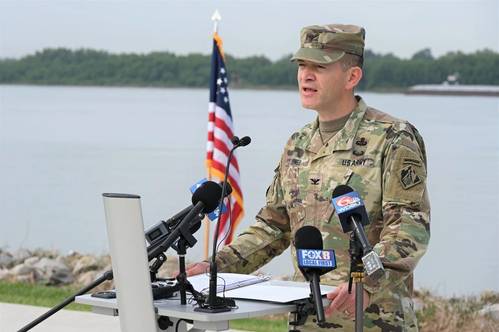USACE Working to Prevent Saltwater from Rising Up the Mississippi

Col. Cullen Jones, USACE New Orleans District commander, briefs media Sept. 15, 2023, on current steps the Corps plans to take to augment the existing underwater sill constructed by USACE in the Mississippi River to help slow progression of the saltwater wedge moving upriver from the Gulf of Mexico. (Photo: Ryan Labadens / U.S. Army)
The U.S. Army Corps of Engineers, New Orleans District is working to delay upriver progression of salt water from the Gulf of Mexico by augmenting the sill initially constructed in July 2023.
Construction is underway to increase the existing underwater sill from a depth of -55 feet to a depth of -30 feet. A 620-foot-wide navigation lane will be kept to a depth of -55 feet to ensure deep-draft shipping continues along the nation’s busiest inland waterway.
USACE initially constructed the underwater barrier sill in July 2023 to create an artificial basin to delay the ingress of salt water beyond river mile 64 above Head of Passes. As a result of the river’s prolonged extreme low-flow rate, the underwater sill was overtopped Sept. 20, 2023.
“As a result of continued falling conditions, this existing sill was overtopped and the toe of the saltwater wedge has reached River Mile 69, near the community of Jesuit Bend,” said Col. Cullen Jones, USACE New Orleans District commander. “Our modeling indicates that by augmenting the existing sill, we can support state and local preparedness and response efforts by delaying further upriver progression of the salt water by approximately 10 to 15 days.”
In addition to the sill augmentation, USACE is preparing to transport fresh water to impacted areas. During previous low-water events, such as 1988 and 2012, barging was used to transport fresh water to treatment facilities downriver of the saltwater toe.
“The Corps is securing water barges that will support impacted water treatment facilities by transporting water collected from portions of the river that do not have salinity readings,” Jones said. “This water can then be combined with water at the municipal facility to create a mixture that is safe for treatment.”
The intrusion of salt water into the river is a naturally occurring phenomenon because the bottom of the riverbed between Natchez, Miss., and the Gulf of Mexico is below sea level. Denser salt water moves upriver along the bottom of the river beneath the less dense fresh water flowing downstream. Under normal conditions, the downstream flow of the river prevents significant upriver progression of the salt water. However, in times of extreme low volume water flow, such as what has been occurring this year, unimpeded salt water can travel upriver and threaten municipal drinking water and industrial water supplies. An underwater sill was constructed on four previous occasions in 1988, 1999, 2012 and last year in 2022.
“As new information becomes available, we will reevaluate the projected movement of the salt water and share this information with our partners and the public for their preparedness, readiness and response,” Jones said.













 December 2025
December 2025



